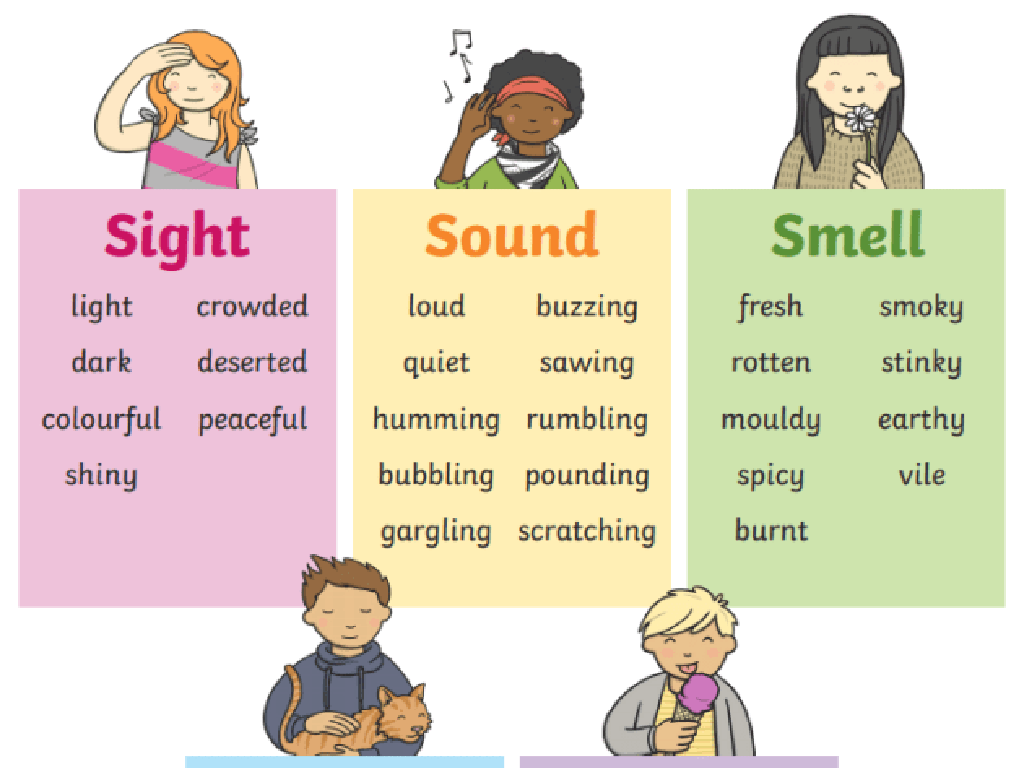Thriving
Subject: Language arts
Grade: High school
Topic: Reading And Vocabulary
Please LOG IN to download the presentation. Access is available to registered users only.
View More Content
Introduction to Thriving
– Understanding ‘Thriving’
– Thriving means to grow vigorously or to flourish.
– ‘Thriving’ in literature & language
– Explore how characters overcome adversity.
– Contextual examples of thriving
– Ecosystems thriving after rain; businesses booming.
– Discuss thriving in personal growth
|
This slide introduces the concept of ‘Thriving’ to students, aiming to deepen their understanding of how it is used in both literature and everyday language. Start by defining ‘Thriving’ as a state of growth or flourishing, which can be applied to various subjects such as plants, businesses, or personal development. Discuss its use in literature, focusing on how characters may thrive despite challenges. Provide examples from different contexts to illustrate the concept, such as ecosystems thriving after a period of rain or a business thriving in a favorable market. Encourage students to think of examples from their own lives or current events where they have observed thriving. This will help them relate the concept to personal growth and resilience.
Exploring the Word ‘Thrive’
– Etymology of ‘thrive’
– Originates from Old Norse ‘thrífa’ meaning to grasp
– ‘Thrive’ in various languages
– German ‘treiben’, Dutch ‘drijven’, and more
– Connotations of ‘thriving’
– Often implies prosperity and positive growth
– ‘Thrive’ in literature and media
|
This slide delves into the word ‘thrive’ and its usage in the English language. Begin with the etymology, explaining that ‘thrive’ comes from Old Norse and has evolved in meaning over time. Compare ‘thrive’ with its counterparts in other Germanic languages to give students a sense of linguistic connections. Discuss the positive connotations of ‘thriving’ and how it’s used to denote success, health, and prosperity. Encourage students to think of examples where they have seen the word used in literature, movies, or media, and how its usage in different contexts can alter its connotation. This will help students understand the importance of context in vocabulary and language arts.
Thriving in Literature
– Identifying ‘Thriving’ in texts
– Look for ‘Thriving’ and its synonyms in various literary works.
– ‘Thriving’ affects tone and mood
– How does ‘Thriving’ influence the reader’s feelings and the atmosphere?
– Reading a descriptive excerpt
– Focus on an excerpt where ‘Thriving’ vividly describes a scene or character.
– Analyzing the use of ‘Thriving’
– Discuss the effectiveness of ‘Thriving’ in conveying the author’s message.
|
This slide aims to explore the word ‘Thriving’ within the context of literature. Students will identify instances of the word and its synonyms in literary texts, discussing how it contributes to the tone and mood of the work. By reading an excerpt where ‘Thriving’ is used descriptively, students will gain insight into how authors use language to paint vivid imagery and evoke emotions. The class will analyze the impact of the word on the narrative and its ability to enhance the reader’s experience. Encourage students to think critically about the word choice and its implications in the text.
Vocabulary Expansion: ‘Thriving’
– Explore synonyms of ‘Thriving’
– Synonyms include: flourishing, prospering, booming
– Learn antonyms of ‘Thriving’
– Antonyms include: failing, declining, withering
– Grammatical use of ‘Thriving’
– Use in various grammatical contexts, e.g., as an adjective: ‘a thriving community’
– Sentence creation practice
– Craft sentences using ‘Thriving’ and its synonyms to enhance understanding
|
This slide aims to broaden students’ vocabulary by focusing on the word ‘Thriving’ and its synonyms and antonyms. Encourage students to think of ‘Thriving’ not just as a word but as a concept that can be applied to various subjects such as economics, biology, and social communities. Discuss the importance of context in determining the appropriate synonym or antonym to use. Provide examples of ‘Thriving’ used in different grammatical contexts, such as adjectives and verbs. Finally, have students practice creating their own sentences to solidify their understanding and ability to use ‘Thriving’ and related words effectively in their writing and discussions.
Thriving in Real Life
– Defining ‘thriving’ in context
– To prosper or flourish in various aspects of life
– Examples of thriving entities
– Individuals like Malala Yousafzai, communities like Silicon Valley, ecosystems like the Amazon Rainforest
– Conditions fostering thriving
– Supportive environments, resources, and opportunities are crucial
– Thriving as a dynamic process
|
This slide aims to explore the concept of thriving beyond the academic definition, applying it to real-world scenarios. Start by defining ‘thriving’ as not just surviving but flourishing and growing in a positive direction. Provide tangible examples of individuals, communities, and ecosystems that exemplify this concept, such as Malala Yousafzai for her educational advocacy, Silicon Valley for technological innovation, and the Amazon Rainforest for biodiversity. Discuss the necessary conditions that allow these examples to thrive, such as supportive communities, access to resources, and opportunities for growth. Highlight that thriving is an ongoing process that requires continuous effort and favorable conditions. Encourage students to think about their own lives and communities in terms of what it means to thrive and what factors contribute to it.
Class Activity: Thriving Skits
– Form small groups for skits
– Create skits on ‘Thriving’ theme
– Imagine scenarios where characters overcome challenges or grow positively
– Perform your skit to the class
– Discuss each group’s portrayal
– Reflect on different perspectives of thriving
|
This activity is designed to engage students in a creative and interactive way to explore the concept of ‘Thriving’. Divide the class into small groups, aiming for diverse representation in each group to foster different perspectives. Each group will create a short skit that illustrates what it means to thrive, which could include overcoming adversity, achieving personal goals, or supporting others in their success. After each group presents their skit, lead a class discussion to reflect on the various portrayals of thriving. Encourage students to consider how the scenarios presented can apply to their own lives. Possible variations of the activity could include writing a group poem, creating a visual art piece, or composing a song about thriving.






